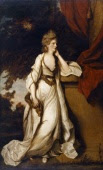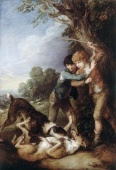British Painters of Kenwood House
 English Heritage site Kenwood House on Hampstead Heath just out of London is the home of the Iveagh Bequest Art Collection. It was acquired by Edward Guinness, the first Earl of Iveagh in the 1880s–1890s. He collected the Old Masters, Dutch and Flemish painters, as well as British ones. His interest was primarily portraits, but he added landscapes to his collection also. Kenwood House itself is worth a visit with architecture by Robert Adam, gorgeous interiors (the library and orangery are of note), and landscape design by Repton.
English Heritage site Kenwood House on Hampstead Heath just out of London is the home of the Iveagh Bequest Art Collection. It was acquired by Edward Guinness, the first Earl of Iveagh in the 1880s–1890s. He collected the Old Masters, Dutch and Flemish painters, as well as British ones. His interest was primarily portraits, but he added landscapes to his collection also. Kenwood House itself is worth a visit with architecture by Robert Adam, gorgeous interiors (the library and orangery are of note), and landscape design by Repton.
Currently, Kenwood House is under renovation and so its art, including the famous Rembrandt self portrait on the right, is on travel. Nearly fifty works are on a North American tour, of which Seattle is one stop. The touring show is called "Rembrandt, van Dyck, Gainsborough: The Treasures of Kenwood House, London." The tour visited Houston in June 2012, Milwaukee in October 2012, and then arrived in Seattle in February 2013. As of today, the paintings are headed out of the U.S.
I was primarily interested in the British portraiture artists of the 17th and 18th centuries, namely, Van Dyck, Joshua Reynolds, Thomas Gainsborough, and George Romney and landscape artists Gainsborough and Joseph Turner since those were the painters most popular during the Regency.
English art of portraiture came into being in the 17th C with Van Dyck's elegant paintings. He was the court painter to King Charles I, and his work was hung in English aristocratic country houses and town homes and inspired generations that British portrait artists.
 Reynolds, the first president of the Royal Academy of Arts, was a pure portrait artist and was heavily influenced by Van Dyck and Reuben. One of his earliest portraits was of the Angerstein Children wherein he developed his signature style that is best showcased by the portrait of Lady Louisa Manners, thereby giving his style the title "Grand Manner Portraits."
Reynolds, the first president of the Royal Academy of Arts, was a pure portrait artist and was heavily influenced by Van Dyck and Reuben. One of his earliest portraits was of the Angerstein Children wherein he developed his signature style that is best showcased by the portrait of Lady Louisa Manners, thereby giving his style the title "Grand Manner Portraits."
Since the Royal Academy paintings were hung from up above with the bottom edge being 5'6" off the ground, painters tended to paint humans with long elongated bodies to compensate for the viewing angles in those days.
 The Infant Academy is a departure from Reynolds's usual style, it's whimsical turning away from the Van Dyck classical learning to paint life as simply as he saw it.
The Infant Academy is a departure from Reynolds's usual style, it's whimsical turning away from the Van Dyck classical learning to paint life as simply as he saw it.
Reynolds's chief rival for art commissions and Royal Academy wall space was Gainsborough. They tried to out-do each other in the drama and size of their paintings and garnering commissions from the wealthiest of patrons.
Gainsborough's Mary, Countess of Howe is considered one of the essential masterpieces of English painting and an icon of English feminine beauty. This is his third life-size full-length portrait. Another of his well-known works is Lady Brisco, also a life-size full-length portrait.

 Gainsborough drew inspiration for his landscapes in the country motifs and architecture in the region around Bath. He claimed that while portrait painting was his profession, landscape painting was his pleasure. Some of his well-known landscapes are: Greyhounds Coursing a Fox (his third largest work executed in the style of Flemish painter Frans Snyder), and Two Shepherd Boys with Two Dogs Fighting.
Gainsborough drew inspiration for his landscapes in the country motifs and architecture in the region around Bath. He claimed that while portrait painting was his profession, landscape painting was his pleasure. Some of his well-known landscapes are: Greyhounds Coursing a Fox (his third largest work executed in the style of Flemish painter Frans Snyder), and Two Shepherd Boys with Two Dogs Fighting.
Reynolds's and Gainsborough's portraiture fell under the heading Allegorical Paintings or History Paintings. They depict scenes from the Bible or Greek and Roman mythology (extending to even Cleopatra). This was considered the most respected artistic genre of 18th C and early 19th C England. An example is The Honorable Mrs. Tollemache where the lady is presented as Miranda from Shakespeare's The Tempest.

0 comments:
Post a Comment